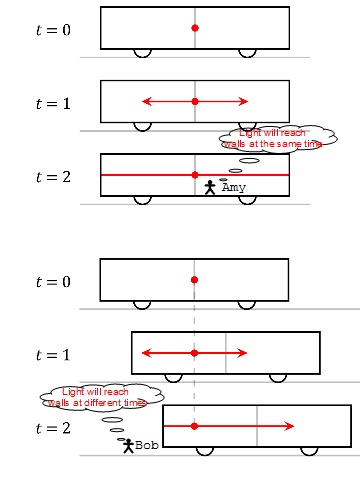Physics Notes - Herong's Tutorial Notes - v3.24, by Herong Yang
What Is the Relativity of Simultaneity
This section provides a quick introduction on the relativity of simultaneity, a phenomenon where two events happening in two different locations that occur simultaneously in one reference frame, occur non-simultaneously in another reference frame that is relatively moving.
What Is the Relativity of Simultaneity? The relativity of simultaneity in special relativity refers to the phenomenon where two events happening in two different locations that occur simultaneously in one reference frame, occur non-simultaneously in another reference frame that is relatively moving.
Or we can say that distant simultaneity, whether two spatially separated events occur at the same time, is not absolute. It is relative to the observer's reference frame.
Or we simply say that simultaneity is relative.
For example, a flash of light is given off at the center of a carriage moving at a high speed. Amy, on the moving carriage, will observe that light pulses will reach the front wall and the back wall at the same time. But Bob, on the ground, will observe that light pulses will reach the front wall and the back wall at different times.

Table of Contents
Introduction of Frame of Reference
Introduction of Special Relativity
Time Dilation in Special Relativity
Length Contraction in Special Relativity
►The Relativity of Simultaneity
►What Is the Relativity of Simultaneity
Formula for the Relativity of Simultaneity
Minkowski Spacetime and Diagrams
Introduction of Generalized Coordinates